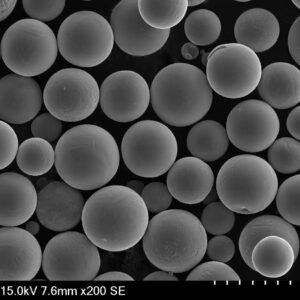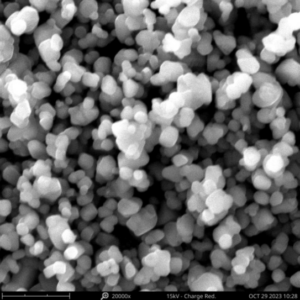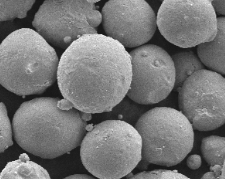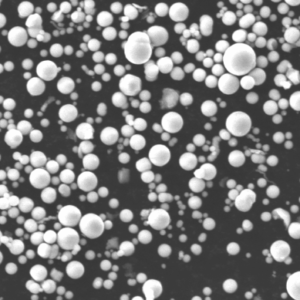Korrosion ist der natürliche Feind von Metallen und verursacht Schäden, die zu kostspieligen Reparaturen oder Ersatzbeschaffungen führen können. Um dies zu bekämpfen, Korrosionsbeständigkeitspulver werden häufig eingesetzt, insbesondere in Umgebungen, in denen korrosive Stoffe wie Wasser, Chemikalien oder Salz vorherrschen. Diese Pulver sind mit spezifischen Metallzusammensetzungen formuliert, um den Korrosionsprozess zu verhindern oder deutlich zu verlangsamen.
In diesem umfassenden Leitfaden tauchen wir in die Welt der Korrosionsschutzpulver ein und erforschen ihre Zusammensetzung, Eigenschaften, Anwendungen und vieles mehr. Ganz gleich, ob Sie Werkstofftechniker, Produktdesigner oder jemand sind, der sich für den Schutz von Metalloberflächen interessiert, dieser Artikel wird Ihnen die nötigen Einblicke geben.
Überblick über Korrosionsbeständiges Pulver
Korrosionsschutzpulver sind fein gemahlene Partikel aus Metallen und Legierungen, die eine Schutzbarriere gegen Oxidation und Korrosion bilden. Diese Pulver können mit verschiedenen Methoden aufgetragen werden, z. B. durch thermisches Spritzen, Pulverbeschichtung und Metallspritzguss. Sie werden in einer Vielzahl von Branchen eingesetzt, darunter die Automobilindustrie, die Luft- und Raumfahrt, die Schifffahrt und das Bauwesen.
Im Folgenden finden Sie einen kurzen Überblick über die Themen dieses Leitfadens:
- Arten von Korrosionsbeständigkeitspulvern: Verschiedene verwendete Metalle und Legierungen.
- Kompositionen: Chemische Zusammensetzung dieser Puder.
- Merkmale: Eigenschaften, die diese Pulver wirksam gegen Korrosion machen.
- Anwendungen: Branchen und Szenarien, in denen diese Pulver verwendet werden.
- Spezifikationen und Normen: Gängige Sorten, Größen und Industriestandards.
- Lieferanten und Preisgestaltung: Wo man sie kaufen kann und was sie kosten werden.
- Vorteile und Benachteiligungen: Vergleich der Vor- und Nachteile der verschiedenen Pulver.
- FAQs: Häufige Fragen zu Korrosionsschutzpulvern.
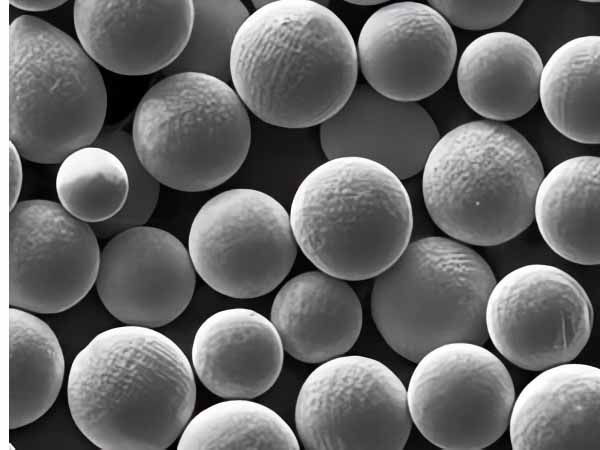
Arten von Korrosionsbeständigkeitspulvern
Es gibt verschiedene Arten von Korrosionsschutzpulvern, die jeweils einzigartige, auf bestimmte Umgebungen zugeschnittene Eigenschaften aufweisen. Hier ein detaillierter Blick auf einige der am häufigsten verwendeten Pulver:
| Typ | Zusammensetzung | Eigenschaften | Am besten geeignet für |
|---|---|---|---|
| Rostfreier Stahl 316L | Eisen, Chrom, Nickel, Molybdän | Ausgezeichnete Korrosionsbeständigkeit, hohe Festigkeit | Marineanwendungen, chemische Verarbeitung |
| Inconel 625 | Nickel, Chrom, Molybdän, Niob | Hohe Temperaturbeständigkeit, hervorragender Korrosionsschutz | Luft- und Raumfahrt, Kernreaktoren |
| Hastelloy C276 | Nickel, Molybdän, Chrom, Wolfram | Außergewöhnliche Korrosionsbeständigkeit, insbesondere gegenüber Säuren | Chemische Verarbeitung, Bekämpfung der Umweltverschmutzung |
| Aluminium 6061 | Aluminium, Magnesium, Silizium | Leichtes Gewicht, gute Korrosionsbeständigkeit | Automobilindustrie, Bauwesen |
| Titan Grad 5 | Titan, Aluminium, Vanadium | Hohe Festigkeit, ausgezeichnete Korrosionsbeständigkeit | Luft- und Raumfahrt, medizinische Implantate |
| Zink | Zink | Eigenschaften einer Opferanode, gut für die Galvanisierung | Automobilindustrie, Bauwesen, elektrische Komponenten |
| Nickel 200 | Nickel | Hervorragende Beständigkeit gegen ätzende Alkalien | Chemische Produktion, Lebensmittelverarbeitung |
| Kupfer-Nickel 90/10 | Kupfer, Nickel | Gute Korrosionsbeständigkeit gegenüber Meerwasser | Marine, Offshore-Öl und Gas |
| Kobalt-Chrom | Kobalt, Chrom | Hohe Verschleißfestigkeit, ausgezeichnete Korrosionsbeständigkeit | Medizinische Implantate, Luft- und Raumfahrt |
| Magnesium AZ91D | Magnesium, Aluminium, Zink | Geringes Gewicht, mäßige Korrosionsbeständigkeit | Automobilindustrie, Luft- und Raumfahrt |
Zusammensetzung der Korrosionsbeständiges Pulver
Das Verständnis der Zusammensetzung von Korrosionsschutzpulvern ist entscheidend für die Auswahl des richtigen Typs für Ihre Anwendung. Verschiedene Elemente in der Zusammensetzung bringen einzigartige Vorteile und Herausforderungen mit sich. Schauen wir uns die wichtigsten Komponenten an:
Rostfreier Stahl 316L
- Eisen (Fe): Unedles Metall für strukturelle Festigkeit.
- Chrom (Cr): Bietet Korrosionsbeständigkeit durch Bildung einer passiven Oxidschicht.
- Nickel (Ni): Erhöht die Zähigkeit und verbessert die Korrosionsbeständigkeit.
- Molybdän (Mo): Verbessert die Beständigkeit gegen Lochfraß und Spaltkorrosion, insbesondere in chlorhaltiger Umgebung.
Inconel 625
- Nickel (Ni): Unedles Metall, das eine ausgezeichnete Oxidations- und Korrosionsbeständigkeit aufweist.
- Chrom (Cr): Verbessert die Oxidationsbeständigkeit bei hohen Temperaturen.
- Molybdän (Mo) und Niob (Nb): Verstärkung der Legierung und Verbesserung ihrer Hochtemperaturstabilität.
Hastelloy C276
- Nickel (Ni): Bietet eine außergewöhnliche Korrosionsbeständigkeit in einer Vielzahl von Umgebungen.
- Molybdän (Mo) und Chrom (Cr): Bieten Widerstand gegen Lochfraß, Spaltkorrosion und Spannungsrisskorrosion.
- Wolfram (W): Erhöht die Beständigkeit der Legierung gegen hochkorrosive Umgebungen.
Diese Zusammensetzungen zeigen, wie verschiedene Elemente zusammenwirken, um Pulver mit einzigartigen Korrosionsschutzeigenschaften zu schaffen. Die Wahl des Pulvers hängt von den spezifischen Anforderungen der Anwendung ab, einschließlich Umweltfaktoren und den mechanischen Anforderungen des zu schützenden Teils oder der Struktur.
Eigenschaften von korrosionsbeständigem Pulver
Um den Wert von Korrosionsschutzpulvern wirklich zu verstehen, sollten wir uns ihre wichtigsten Eigenschaften genauer ansehen:
- Korrosionsbeständigkeit: Die Hauptfunktion dieser Pulver ist der Schutz des Substrats vor Oxidation und chemischen Reaktionen, die eine Verschlechterung verursachen.
- Haftung: Sie haften gut auf dem Untergrund und gewährleisten einen dauerhaften Schutz, ohne abzublättern oder zu schälen.
- Abnutzungswiderstand: Viele dieser Pulver bieten auch eine ausgezeichnete Verschleißfestigkeit, was bei Anwendungen mit Reibung oder abrasiven Bedingungen entscheidend ist.
- Temperaturbeständigkeit: Pulver wie Inconel 625 und Hastelloy C276 können extremen Temperaturen standhalten und sind daher für Hochtemperaturumgebungen geeignet.
- Mechanische Festigkeit: Diese Pulver schützen nicht nur vor Korrosion, sondern können auch die mechanische Festigkeit des beschichteten Materials erhöhen.
- Chemische Verträglichkeit: Die verschiedenen Pulver sind gegen unterschiedliche Arten von Chemikalien beständig, sei es in sauren, basischen oder salzhaltigen Umgebungen.
- Umwelt und Sicherheit: Angesichts wachsender Umweltbedenken sind viele dieser Pulver so konzipiert, dass sie umweltfreundlich sind und nur wenige gefährliche Bestandteile enthalten.
Anwendungen von Korrosionsbeständiges Pulver
Korrosionsbeständige Pulver finden in einer Vielzahl von Branchen Anwendung. Hier sehen Sie, wie sie in einigen Schlüsselsektoren eingesetzt werden:
| Industrie | Anmeldung | Pulver Typ | Vorteile |
|---|---|---|---|
| Marine | Schiffsrümpfe, Offshore-Plattformen | Kupfer-Nickel 90/10, Edelstahl 316L | Schützt vor Korrosion durch Seewasser |
| Luft- und Raumfahrt | Strahltriebwerke, Strukturkomponenten | Inconel 625, Titan Grad 5 | Widersteht Hochtemperaturkorrosion, reduziert das Gewicht |
| Automobilindustrie | Auspuffanlagen, Konstruktionsteile | Aluminium 6061, Zink | Leichtes Gewicht, schützt vor Streusalzen |
| Chemische Verarbeitung | Reaktoren, Pipelines, Lagertanks | Hastelloy C276, Nickel 200 | Widersteht sauren und ätzenden Umgebungen |
| Bauwesen | Brücken, Gebäude, Bewehrungsstäbe | Rostfreier Stahl 316L, Zink | Langlebigkeit bei rauen Außenbedingungen |
| Medizinische | Implantate, chirurgische Instrumente | Kobalt-Chrom, Titan Grad 5 | Biokompatibilität, Korrosionsbeständigkeit in Körperflüssigkeiten |
| Öl und Gas | Bohrlochwerkzeuge, Pipelines, Ventile | Inconel 625, Kupfer-Nickel 90/10 | Korrosionsbeständigkeit unter hohem Druck und hoher Temperatur |
| Elektronik | Steckverbinder, PCBs, Gehäuse | Nickel 200, Zink | Verhindert Korrosion an elektrischen Kontakten |
| Stromerzeugung | Turbinenschaufeln, Wärmetauscher | Hastelloy C276, Inconel 625 | Geeignet für hohe Hitze und korrosive Umgebungen |
| Lebensmittelverarbeitung | Maschinenpark, Rohrleitungen | Rostfreier Stahl 316L, Nickel 200 | Hält die Hygiene aufrecht, widersteht Speisesäuren |
Spezifikationen, Größen und Normen
Um das richtige Korrosionsschutzpulver auszuwählen, müssen Sie die Spezifikationen, Größen und Normen kennen, die für Ihren Bedarf gelten. Hier ist eine Aufschlüsselung:
| Pulver Typ | Verfügbare Größen (Mikron) | Gemeinsame Normen | Klassen |
|---|---|---|---|
| Rostfreier Stahl 316L | 15-45, 45-75 | ASTM A276, ISO 15156-3 | 316L, 316F |
| Inconel 625 | 15-53, 53-150 | AMS 5666, ASTM B446 | UNS N06625 |
| Hastelloy C276 | 15-45, 45-75 | ASTM B575, ASME SB-575 | UNS N10276 |
| Aluminium 6061 | 20-60, 60-90 | ASTM B209, ISO 6362 | 6061-T6, 6061-T651 |
| Titan Grad 5 | 15-45, 45-75 | ASTM B348, ISO 5832-3 | Güteklasse 5 (Ti-6Al-4V) |
| Zink | 20-50, 50-100 | ASTM B6, ISO 752 | SHG, HG |
| Nickel 200 | 15-53, 53-150 | ASTM B160, ASME SB-160 | UNS N02200 |
| Kupfer-Nickel 90/10 | 15-45, 45-75 | ASTM B122, ISO 6208 | C70600, CW352H |
| Kobalt-Chrom | 10-45, 45-75 | ASTM F75, ISO 5832-4 | CoCrMo, L605 |
| Magnesium AZ91D | 20-60, 60-90 | ASTM B93/B93M, ISO 16220 | AZ91D, AZ91E |
Diese Normen und Spezifikationen gewährleisten, dass die Pulver die erforderlichen Qualitäts- und Leistungskriterien für die vorgesehenen Anwendungen erfüllen.
Lieferanten und Preisangaben
Beim Kauf von Korrosionsschutzpulvern ist es wichtig, sowohl auf die Qualität des Produkts als auch auf die Zuverlässigkeit des Lieferanten zu achten. Im Folgenden finden Sie eine Liste einiger bekannter Anbieter sowie eine allgemeine Preisübersicht:
| Anbieter | Standort | Angebotene Pulvertypen | Preisspanne (USD/kg) |
|---|---|---|---|
| Höganäs AB | Schweden | Rostfreier Stahl 316L, Inconel 625, Kupfer-Nickel 90/10 | $50 – $150 |
| Tischlertechnik | USA | Titan Grad 5, Kobalt-Chrom, Hastelloy C276 | $100 – $250 |
| Sandvik Werkstofftechnik | Schweden | Rostfreier Stahl 316L, Inconel 625 | $60 – $200 |
| Kennametal | USA | Kobalt-Chrom, Inconel 625, Nickel 200 | $80 – $220 |
| Praxair Oberflächentechnologien | USA | Hastelloy C276, Aluminium 6061, Zink | $40 – $130 |
| VSMPO-AVISMA | Russland | Titan Grad 5, Aluminium 6061 | $120 – $300 |
| AMETEK SMP Eighty Four | USA | Nickel 200, Kupfer-Nickel 90/10, Magnesium AZ91D | $70 – $180 |
| Metco (Oerlikon) | Schweiz | Inconel 625, Hastelloy C276, Zink | $90 – $240 |
| Erweiterte Pulver & Beschichtungen | Kanada | Edelstahl 316L, Aluminium 6061 | $50 – $140 |
| Tekna | Kanada | Titan Grad 5, Inconel 625, Magnesium AZ91D | $110 – $290 |
Die Preise können je nach Art des Pulvers, der bestellten Menge und des Lieferanten erheblich variieren. Es ist immer ratsam, Angebote einzuholen und Optionen zu vergleichen, bevor Sie einen Kauf tätigen.
Vorteile und Nachteile von korrosionsbeständigem Pulver
Jedes Material hat seine Stärken und Schwächen, und Korrosionsschutzpulver bilden da keine Ausnahme. Hier finden Sie einen Vergleich der Vor- und Nachteile der Verwendung dieser Pulver:
| Vorteil | Erläuterung |
|---|---|
| Hohe Korrosionsbeständigkeit | Schützt Metalloberflächen vor einer Vielzahl von korrosiven Umgebungen. |
| Verbesserte mechanische Eigenschaften | Verbessert die Festigkeit und Haltbarkeit des beschichteten Materials. |
| Vielseitigkeit | Geeignet für eine Vielzahl von Anwendungen in unterschiedlichen Branchen. |
| Temperaturbeständigkeit | Behält seine Integrität bei hohen Temperaturen, ideal für die Luft- und Raumfahrt und die Energieerzeugung. |
| Kosteneffizienter Schutz | Verlängert die Lebensdauer von Metallteilen und verringert die Notwendigkeit eines häufigen Austauschs. |
| Nachteil | Erläuterung |
|---|---|
| Kosten | Einige Pulver, insbesondere solche aus seltenen oder teuren Materialien, können sehr teuer sein. |
| Komplexes Antragsverfahren | Erfordert spezielle Ausrüstung und Fachkenntnisse für die richtige Anwendung. |
| Begrenzte Verfügbarkeit | Nicht alle Pulversorten sind ohne weiteres erhältlich, insbesondere Speziallegierungen. |
| Umweltaspekte | Einige Puder können Bestandteile enthalten, die nicht umweltfreundlich sind. |
| Vorbereitung der Oberfläche | Erfordert eine gründliche Reinigung und Vorbereitung des Untergrunds für eine optimale Haftung. |

FAQs
Im Folgenden finden Sie eine Sammlung häufig gestellter Fragen zu Korrosionsschutzpulvern, um eventuelle Zweifel auszuräumen.
| Frage | Antwort |
|---|---|
| Was ist Korrosionsschutzpulver? | Korrosionsschutzpulver ist ein fein gemahlenes Metall- oder Legierungspulver, das zum Schutz von Metalloberflächen vor Korrosion verwendet wird. |
| Wie wird Korrosionsschutzpulver aufgetragen? | Es kann durch Verfahren wie thermisches Spritzen, Pulverbeschichtung oder Metallspritzguss aufgebracht werden. |
| Welche Branchen profitieren am meisten von der Verwendung dieser Pulver? | Branchen wie die Luft- und Raumfahrt, die Automobilindustrie, die Schifffahrt und die chemische Verarbeitung profitieren erheblich von diesen Pulvern. |
| Sind Korrosionsschutzpulver umweltfreundlich? | Viele sind so konzipiert, dass sie umweltfreundlich sind, obwohl dies von der jeweiligen Pulverart abhängt. |
| Wie wähle ich das richtige Korrosionsschutzpulver aus? | Berücksichtigen Sie die Umgebungsbedingungen, die erforderlichen Eigenschaften und die Verträglichkeit mit dem Untergrund. |
| Können korrosionsbeständige Pulver die mechanische Festigkeit verbessern? | Ja, einige Pulver verbessern die mechanische Festigkeit des beschichteten Materials. |
| Welches sind die gemeinsamen Normen für diese Pulver? | Normen wie ASTM, ISO und AMS werden üblicherweise verwendet, um Qualität und Leistung zu gewährleisten. |
| Gibt es einen signifikanten Kostenunterschied zwischen den verschiedenen Pulversorten? | Ja, die Kosten variieren je nach Materialzusammensetzung, Verfügbarkeit und Anbringungsmethode. |
| Kann ich Korrosionsschutzpulver zu Hause auftragen? | Die Anbringung erfordert in der Regel spezielle Geräte und Fachkenntnisse, weshalb sie in der Regel von Fachleuten durchgeführt wird. |
| Wie lange ist die Haltbarkeit von Korrosionsschutzpulver? | Die meisten Pulver sind bei sachgemäßer Lagerung in einer trockenen, kühlen Umgebung lange haltbar. |
Schlussfolgerung
Korrosionsbeständige Pulver spielen eine entscheidende Rolle bei der Verlängerung der Lebensdauer von Metallkomponenten, indem sie einen robusten Schutz gegen die rauen Auswirkungen von Korrosion bieten. Durch die Wahl der richtigen Art von Pulver, die Kenntnis seiner Zusammensetzung und die korrekte Anwendung können Sie Ihre Anlagen schützen und eine lange Lebensdauer gewährleisten.
Egal, ob Sie in der Luft- und Raumfahrt, im Automobilbau, in der Schifffahrt oder in einer anderen Branche arbeiten, in der Metallschutz erforderlich ist - Korrosionsschutzpulver bieten eine vielseitige und effektive Lösung. Der Schlüssel liegt in der Auswahl des richtigen Pulvers für Ihre spezifischen Anforderungen und in der Zusammenarbeit mit seriösen Lieferanten, um sicherzustellen, dass Sie das beste Produkt zum richtigen Preis erhalten.
Wenn Sie weitere Fragen haben, können Sie sich gerne an uns wenden, und vergessen Sie nicht, sich bei der Planung Ihres nächsten Projekts über die verschiedenen Pulversorten und ihre einzigartigen Eigenschaften zu informieren.


